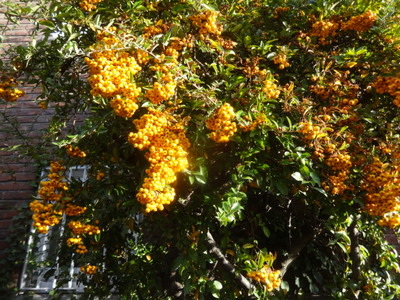
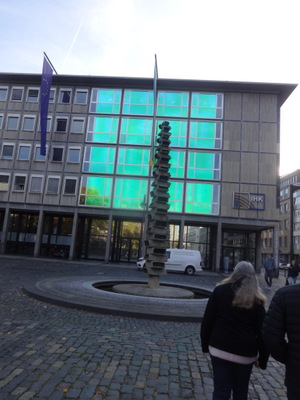 Marek had told us the evening before that Cologne has a population a little over 1 million. He added that both the chocolate museum and the fragrance museum would be open while we were there, but I'm afraid David and I took no advantage of them.
Marek had told us the evening before that Cologne has a population a little over 1 million. He added that both the chocolate museum and the fragrance museum would be open while we were there, but I'm afraid David and I took no advantage of them.Monday, 10 October, Cologne, Germany (and its beer culture)
Written 17 March 2023
The ship was scheduled to leave Koblenz at 2:00 am, and I assume that it did—I did not stay up to see. But I did see that it arrived in Cologne (Köln, in German) on schedule at 8:30 am. For the 9:00 am walking tour, David and I once again joined the "leisurely" group. Jan headed off a few minutes later for "Cologne by bicycle" and in fact bicycled past us at one point in midmorning.

 Marek had told us the evening before that Cologne has a population a little over 1 million. He added that both the chocolate museum and the fragrance museum would be open while we were there, but I'm afraid David and I took no advantage of them.
Marek had told us the evening before that Cologne has a population a little over 1 million. He added that both the chocolate museum and the fragrance museum would be open while we were there, but I'm afraid David and I took no advantage of them.
We weren't docked in town, so a bus took us into the center of things to meet our 56-year-old guide, Mohammed (called "Mo"). His last name, which I didn't catch, was German, but his mother was Moroccan.
The first thing that caught my eye was this striking Pyracantha with yellow berries—they're usually red, but this is a nice effect.
The second thing was this interesting sculpture, which served as a useful landmark during our walk. It's a stack of boxes, open at both ends, each one shaped like those mailboxes that are wider than they are tall, and these decreased gradually in size from bottom to top. The modern building behind it is the, IHK, the Industry and Trade Chamber.

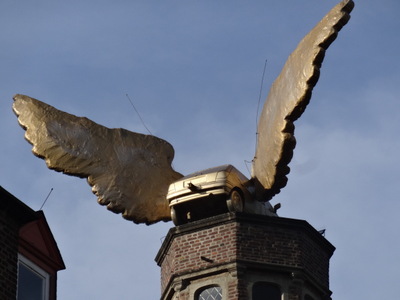 Local industries include Bayer pharmaceuticals (in a neighboring community about 10 miles away) and automobile manufacturing, which provides 30,000 jobs for the city.
Local industries include Bayer pharmaceuticals (in a neighboring community about 10 miles away) and automobile manufacturing, which provides 30,000 jobs for the city.
According to Mo, the most popular car in Cologne is not Toyota or even Volkswagen (made in Wolfsburg in Lower Saxony); it is the Ford (despite the joke that the name stands for "Fix Or Repair Daily"). Fords have been made here since 1927. The building at the left is Ford headquarters (it was the armory in medieval times; red and white are the colors of Cologne), and just out of the first shot, to the right, is this tower topped by a winged car. Not just any car, Mo assured us, but a 1987 Ford Festa. Ford cars built in Cologne apparently routinely come in first on racing day.

 The town is 2000 years old. It was founded by the Romans, specifically to to defend the newly acquired territories west of the Rhine.
The town is 2000 years old. It was founded by the Romans, specifically to to defend the newly acquired territories west of the Rhine.
Rather than just showing up and taking over, the Romans apparently often made overtures of peace in advance. Groups that signed treaties of peace could become friends of the Roman empire—in that way, a barbarian could start a sort of apprentice to Roman citizenship. The Roman commander would introduce his wife to the wife of the local head man, and they would talk about the benefits of becoming a Roman. The Ubii were the tribe that agreed and therefore became the first population of Cologne (the name of the city comes from the Roman "Colonia Claudia"). The place has grown a good deal since, and Mo pointed out that all those million people are using infrastructure built for 20–30,000.
At the left here are some Roman ruins uncovered during excavations, now glassed in for viewing. Down a long flight of stairs that went beyond where Mo was taking us, he pointed out a section of old Roman road.
At the right is a building prominently labeled "No. 4711." Mo reminded us that Cologne is the home of "eau de cologne" and that NO. 4711 is a famous brand thereof.

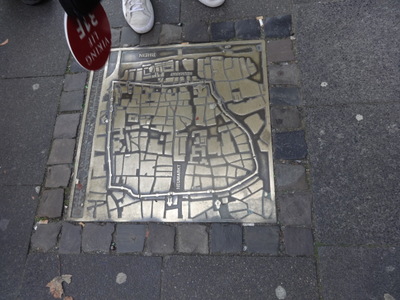 On the way to the cathedral we came first to this bronze plaque set in the sidewalk. It commemorates Elisabeth Friede, born 1884, deported 1941, fate unknown.
On the way to the cathedral we came first to this bronze plaque set in the sidewalk. It commemorates Elisabeth Friede, born 1884, deported 1941, fate unknown.
Next, Mo stopped to show us this bronze map of the old town. To the Romans, a proper walled town was a square 1 km per side, but they sometimes had to go with the topography and watercourses, so this one isn't quite square. The wall is gone now—you can see the cathedral actually overlapping its position near the far left corner, where Mo is pointing with his lollypop.
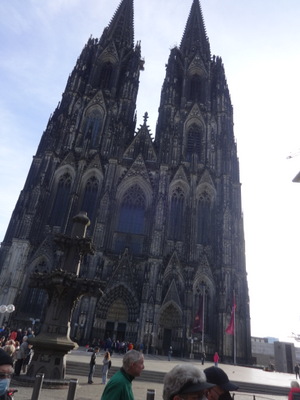
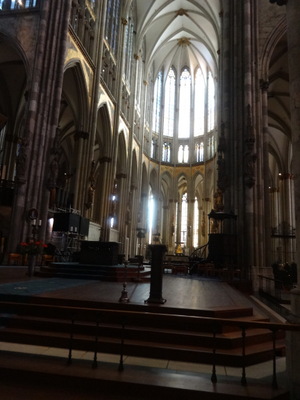 They say that, back in 1248, when the Pope saw the plans for St. Peter's Cathedral, which the town was seeking permission to build, he laughed, then said go ahead, knock yourselves out. He never thought they'd actually do it. It took them 632 years (probably some sort of record), but they did. Apparently nothing much happened between 1473 and 1842—a massive wooden crane that stood on top of one of the unfinished towers was a fixture of the skyline for 500 years! (You can Google up 19th-century photos of it.) As Mo pointed out, in those days if you lived into your 40's, you were the oldest person in town, so that was a lot of generations. But once they got going again, they finished it according to the original medieval plans, so it's nice and symmetrical and resolutely Gothic, not like some of those cathedrals where they built one tower then changed architectural styles before building the other. The previous church that had stood on the site since 1000 AD had been romanesque. It's now a UNESCO World Heritage site.
They say that, back in 1248, when the Pope saw the plans for St. Peter's Cathedral, which the town was seeking permission to build, he laughed, then said go ahead, knock yourselves out. He never thought they'd actually do it. It took them 632 years (probably some sort of record), but they did. Apparently nothing much happened between 1473 and 1842—a massive wooden crane that stood on top of one of the unfinished towers was a fixture of the skyline for 500 years! (You can Google up 19th-century photos of it.) As Mo pointed out, in those days if you lived into your 40's, you were the oldest person in town, so that was a lot of generations. But once they got going again, they finished it according to the original medieval plans, so it's nice and symmetrical and resolutely Gothic, not like some of those cathedrals where they built one tower then changed architectural styles before building the other. The previous church that had stood on the site since 1000 AD had been romanesque. It's now a UNESCO World Heritage site.
The interior shot at the right is just the choir—the full length of the nave was behind me.
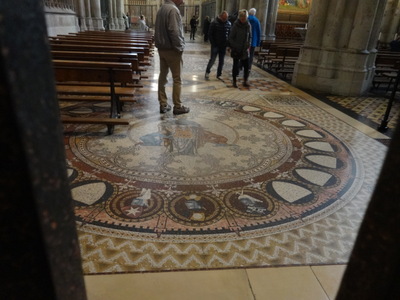
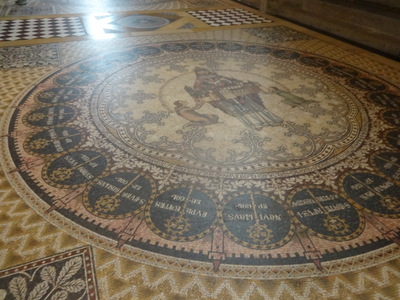 The most striking artwork in the cathedral is its 1350-square-meter mosaic floor, completed in 1899. It's magnificent and shows darn little wear despite being walked all over for so long.
The most striking artwork in the cathedral is its 1350-square-meter mosaic floor, completed in 1899. It's magnificent and shows darn little wear despite being walked all over for so long.
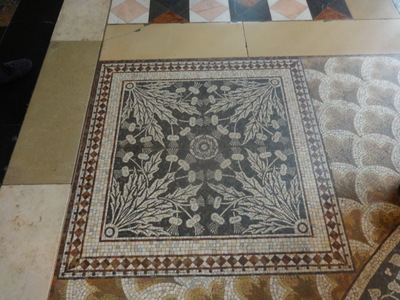
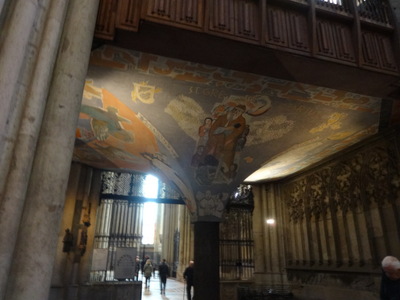 This little section of it even features thistles.
This little section of it even features thistles.
Down in the crypt a lot of the original polychrome frescoes are still visible.
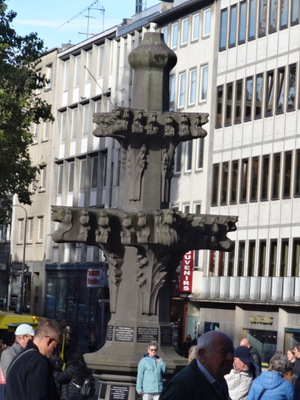
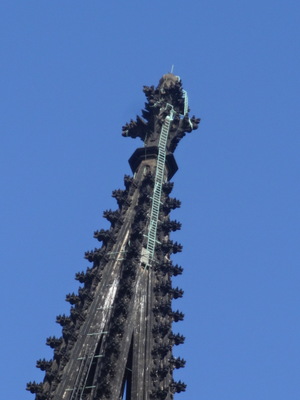 Outside the cathedral, they've erected a life-size replica of one of the pinnacles on the tops of the spires (which are 157 m tall). As you can see in the left-hand photo, it's big!
Outside the cathedral, they've erected a life-size replica of one of the pinnacles on the tops of the spires (which are 157 m tall). As you can see in the left-hand photo, it's big!
At the right, a telephoto shot of one of the real ones, showing the hair-raising ladders that lead to the top. I guess somebody has to go up there sometimes to clean, check for damage, replace melted lightning rods, etc. They keep falcons to hold the pigeon population in check, but Mo said the falcons don't attack the local resident pigeons, just the "incomers" from other neighborhoods.
Written 20 March 2023
Cathedrals are apparently in perpetual competition for "biggest," and because "biggest" can be defined in several ways (height, length, interior volume, exterior volume, mass of stone, surface area covered, etc., etc.), they all claim the honor. Apparently Cologne admits thet the one in Seville is "bigger," and the one in Ulm is taller. I know Speyer is in there somewhere—surface area or length, maybe.
Strangely, the cathedral belongs to itself; it is not owned by the Catholic church. The church rents it for a small annual fee. The chapter of the cologne church is responsible for cleaning, upkeep, etc., which are financed by donations and bequests. They are currently replacing all the damaged and blackened stone from the war; the job will take about 350 years. Parts are also being coated with something that seals the porosity of the sandstone so that, next time, it can be washed.Mo reminded us that Germany has only existed since 1871. Before that it was the Holy Roman Empire. After the Franco-Prussian war, the Prussians united to form Germany. Before that, bishops ruled here. The largest beer house in Germany now occupies the spot where the archbishops palace stood, next to the cathedral. South of the cathedral, they're reconstructing the 18th (maybe 19th) century Dom Hotel.
We were supposed to pass through the museum on our way to our next stop, but it was closed; Mo forgot it was Monday.
In 1794, when French troops arrived, Cologne surrendered immediately, so it suffered no damage in that war. In WWII, though, the place was leveled, except for the cathedral. The cathedral took a lot of damage but never collapsed. According to Mo, the cathedral involves as much stone below as above ground, and that massive counterweight kept it from toppling from shock and rocking.
Nearby, the battle of Hürtgen Forest was terribly bloody, but it after the battle of the bulge and is almost forgotten.
Mo was born in 1965 here in Germany, and as he pointed out, WWII made that possible. People here are very tolerant and will accept all kinds—except those who express sympathy for the Nazis.
He added, for our edification, that Germany, with a population of 83 million people, has less than 1000 homicides a year, but beware, because that doesn't mean they don't have pickpockets.
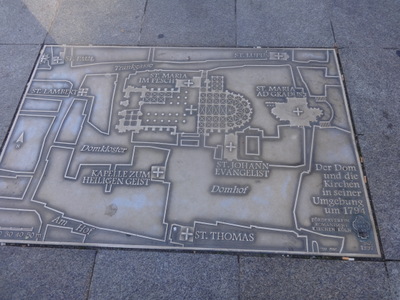
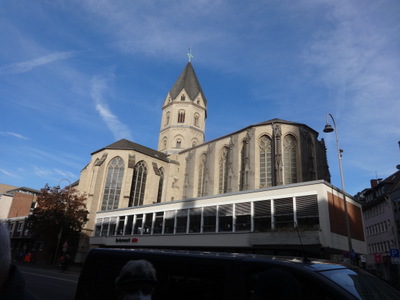 Near the cathedral is another bronze map, this one showing mainly the cathedral and all its little dependent churches and enclosures.
Near the cathedral is another bronze map, this one showing mainly the cathedral and all its little dependent churches and enclosures.
Just off the edge of it, near the top left, is St. Andrew's church (St. Andreas in German), which has a single octagonal tower. It's older than the cathedral, 10th century, and is in romanesque style.
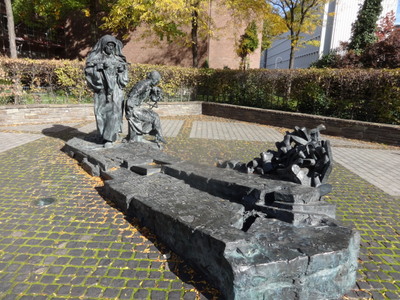
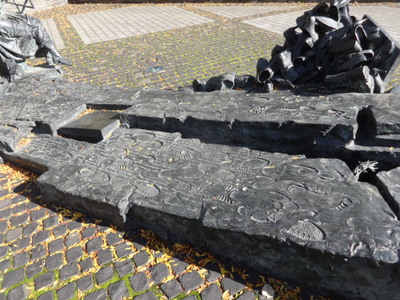 Also nearby is this bronze monument to Edith Stein, a beatified Catholic nun who was deported to and died at Auschwitz because, before converting to Catholicism, she had been born Jewish.
Also nearby is this bronze monument to Edith Stein, a beatified Catholic nun who was deported to and died at Auschwitz because, before converting to Catholicism, she had been born Jewish.
All three of the figures represent Stein, in different aspects of her identity. At the left, you can see the figure of her as a nun carrying a crucifix (Jesus' head is bent forward and hard to see). She is walking a path trodden by many feet; a pile of discarded shoes evokes the death camps.
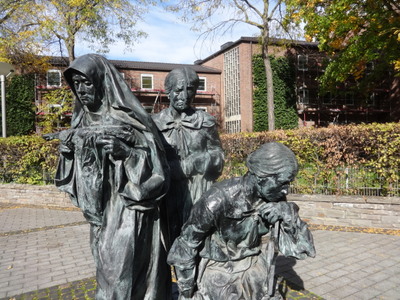
 In the closer view at the left here, you can see that the standing figure behind the nun has been cleft in two, from top to bottom, and the two halves offset from one another.
In the closer view at the left here, you can see that the standing figure behind the nun has been cleft in two, from top to bottom, and the two halves offset from one another.
On the large expanse of parvis right in front of the cathedral, a sidewalk artist was working on this huge circle enclosing emblems of the world's nations in heart-shaped patches. Ukraine is particularly prominent in a circle nearest the camera. The inscription at the near edge calls for world peace.

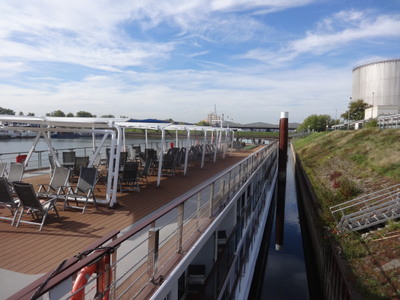 Then it was back to the ship for lunch. At the left here, through the bus window and beyond David's sleeve, you can see our ship in the foreground and another just like it in the far background. This rectangular basin is one of the ports where Viking parks its ships for overhaul in the off season. Eight or ten of them can be moored, side by side, nose to the bank. We were only there because all Vikings other mooring options in the area were occupied.
Then it was back to the ship for lunch. At the left here, through the bus window and beyond David's sleeve, you can see our ship in the foreground and another just like it in the far background. This rectangular basin is one of the ports where Viking parks its ships for overhaul in the off season. Eight or ten of them can be moored, side by side, nose to the bank. We were only there because all Vikings other mooring options in the area were occupied.
At the right is a view, from the boarding ramp, of the sundeck and its shade structure. In the far distance, near the stern, you can make out the herb garden and putting green.
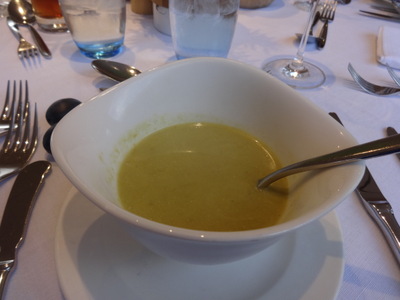
 Lunch started with asparagus soup with julienne of smoked salmon (lovely combination).
Lunch started with asparagus soup with julienne of smoked salmon (lovely combination).
For my main course, I chose the hand-carved roast leg of lamb with white beans and thyme. What's not to like?
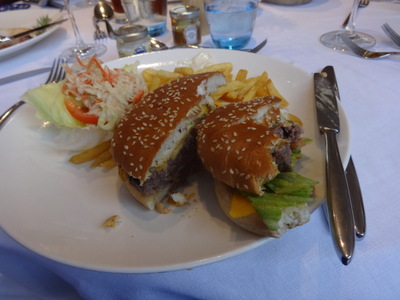
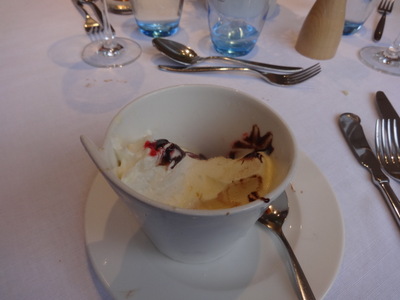 Somebody else (Ron maybe?) ordered the cheeseburger off the always-available menu. To each his own . . . .
Somebody else (Ron maybe?) ordered the cheeseburger off the always-available menu. To each his own . . . .
My dessert was the dame blanche—vanilla ice cream, crisp meringue, chocolate sauce, and raspberry sauce. Raspberry sauce does not ordinarily belong in a dame blanche, but it was good nonetheless. The other choice was brown sugar and cinnamon baked apple with caramel sauce—excellent; I'd had it before—but I was in the mood for ice cream.
We spent the afternoon on the boat, although a bus shuttle service was offered for those who wanted to go back into town for time there on their own.
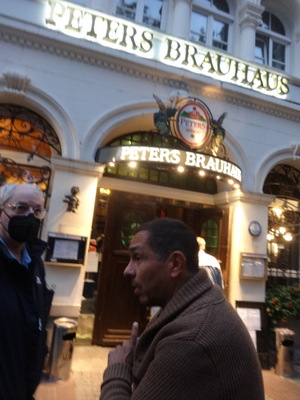
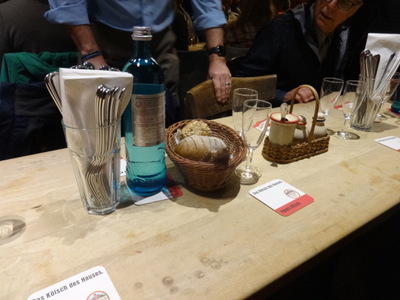 The dinner menu looked good, but we didn't get to taste it (too bad; they were having those yummy crêpe suzettes again).
The dinner menu looked good, but we didn't get to taste it (too bad; they were having those yummy crêpe suzettes again).
We (and about a dozen others) had signed up for the "Cologne beer culture" dinner, a sort of beer-based evening pub crawl to sample Cologne tradmark beer—kölsch. Once back downtown, the group was divided into two. At the left here is the first stop for our group, Peters Brauhaus. We sat at long wooden tables appointed as you see at the right, with baskets of dark bread, glasses full of napkins and flatware, and bottles of still water. Peters was a brauhaus in 1552 too, but it was then several other things before becoming Peters in 1994.
Mo was our guide again. He said the city has 26 brewers but only 11 produce kölsch. Kölsch is always a pale ale—not a lager, not a wheat beer—and is much older than the other brews. It's top fermented and has a short shelf life; you drink it from the barrel within the day.
The usual Oktoberfest beer cliché is the huge steins and the pretzels. That, Mo said firmly, is Bavaria. Here you have herring and black bread or soup with onions and vegetables with black bread and butter. Here in Westphalia they make pumpernickel, which is soft and caramelized. Westphalians, he said, are honest and good people, hard workers, but they don't talk and they drink more.
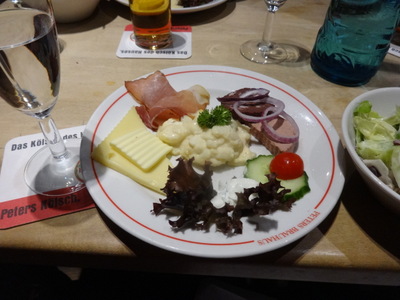
 At the left here is the appetizer plate each of us was served, together with a salad you can see at the right edge, and kölsch ad lib. Kölsch is served not in huge steins but in tall narrow glasses, maybe 8 oz capacity. The waitresses brought around tray after tray of them. The trays consist of a solid round metal floor and a round metal disk the same size but pierced by a couple of dozen holes just the right size for the skinny glasses, both mounted (the disk a few inches above the floor) on a vertical post with a handle on top. The waitress arrives frequently at the table with one of these contraptions loaded with glasses of beer and hands out then out to whever will take one.
At the left here is the appetizer plate each of us was served, together with a salad you can see at the right edge, and kölsch ad lib. Kölsch is served not in huge steins but in tall narrow glasses, maybe 8 oz capacity. The waitresses brought around tray after tray of them. The trays consist of a solid round metal floor and a round metal disk the same size but pierced by a couple of dozen holes just the right size for the skinny glasses, both mounted (the disk a few inches above the floor) on a vertical post with a handle on top. The waitress arrives frequently at the table with one of these contraptions loaded with glasses of beer and hands out then out to whever will take one.
At the right is the first main course: a slice of potroasted beef topped with a sort of cinnamon-raisin sauce and sprinkled with almonds (Mo says in the Rhineland sauerkraut is always accompanied by cinnamon, raisins, and almonds), a couple of rather gummy potato dumplings, and apple compote. Germans distinguish between apple mousse (smooth applesauce) and apple compote (lumpy applesauce). I added bread from the basket and butter provided on plates.

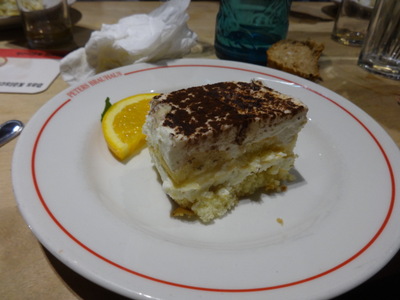 The second main course was excellent braised pork hocks with braised cabbage. As you can see, not much of mine was left behind.
The second main course was excellent braised pork hocks with braised cabbage. As you can see, not much of mine was left behind.
Dessert was a local specialty I didn't catch the name of. It was like a tiramisu without the coffee, but with the addition of apple and pineapple marinated in beer—it was really good!
I was drinking the bottled still water on the table, and the lady sitting next to me was drinking it, too, but having beer as well. I was a little leery, as "still" water in Germany is often terrible; it doesn't have enough carbon dioxide in it to be considered "sparkling," just enough to make it horribly sour. But this (Selters Naturell) was quite palatable.
At the end of the meal we were offered tiny bottles of "bitters," intended as digestives, like the stuff we sampled in Budapest. I tasted it, and it wasn't bad, but the lady next to me said just what I was thinking—"tastes like cough syrup." "Exactly," I replied, "Vick's Formula 44!"
After Peters, we went on to Päffgen Kölsch to taste another version of the stuff, and to be offered more tiny bottles of a different brand of digestive. My neighbor and I again poured ourselves glasses of the bottled water on the table, took simultaneous swigs, made simultaneous yucky-faces, and asked Mo if we couldn't get some tap water. This one, Rodeus brand, was dreadful. Mo was astonished—there's a difference?! You betcha, we assured him, and he hailed a waiter for us. Beer and wine drinkers are not the only ones with preferences.
 Finally, here's a photo of our group at Peters, taken for us by the waitress. That's me and David across from each other at the far end of the table.
Finally, here's a photo of our group at Peters, taken for us by the waitress. That's me and David across from each other at the far end of the table.
Previous entry List of Entries Next entry